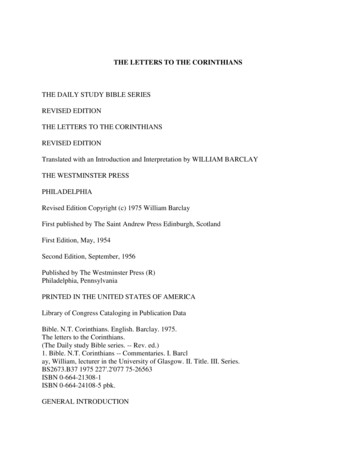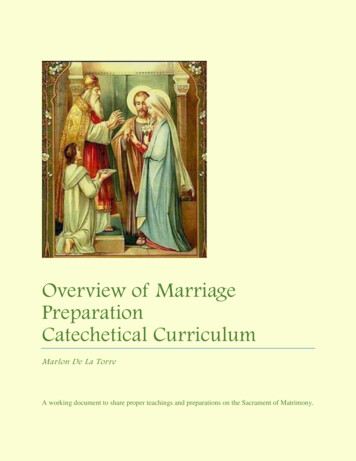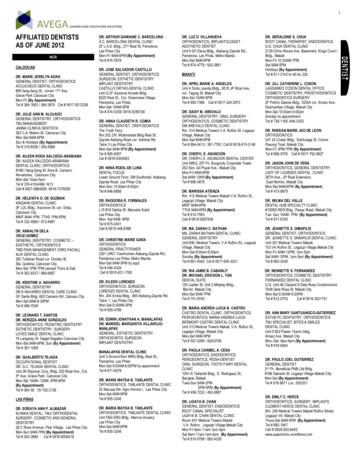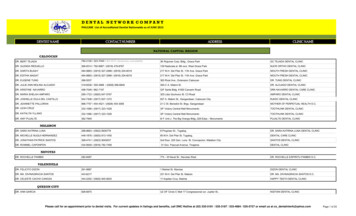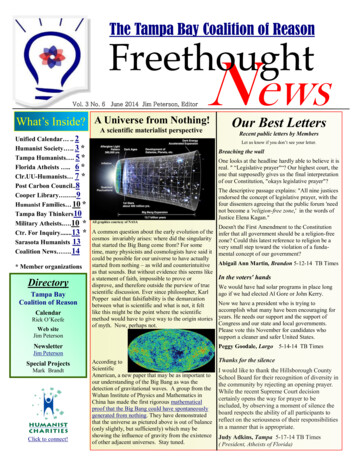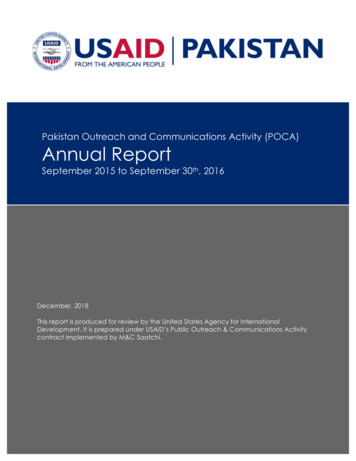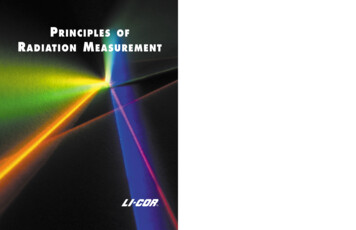
Transcription
P RINCIPLES OFR ADIATION M EASUREMENT
RADIATION MEASUREMENTMuch confusion has existed regarding the measurement of radiation. This report presents a comprehensive summary of theterminology and units used in radiometry, photometry, and themeasurement of photosynthetically active radiation (PAR).Measurement errors can arise from a number of sources, andthese are explained in detail. Finally, the conversion of radiometric and photometric units to photon units is discussed. In thisreport, the International System of Units (SI) is used unlessnoted otherwise (9).RADIOMETRYRadiometry (1) is the measurement of the properties of radiantenergy (SI unit: joule, J), which is one of the many interchangeable forms of energy. The rate of flow of radiant energy, in theform of an electromagnetic wave, is called the radiant flux (unit:watt, W; 1 W 1 J s-1) Radiant flux can be measured as it flowsfrom the source (the sun, in natural conditions), through one ormore reflecting, absorbing, scattering and transmitting media(the Earth's atmosphere, a plant canopy) to the receiving surfaceof interest (a photosynthesizing leaf) (8).Terminology and UnitsRadiant Flux is the amount of radiation coming from a sourceper unit time. Unit: watt, W.Radiant Intensity is the radiant flux leaving a point on thesource, per unit solid angle of space surrounding the point. Unit:watts per steridian, W sr -1.Radiance is the radiant flux emitted by a unit area of a source orscattered by a unit area of a surface. Unit: W m-2 sr -1.Irradiance is the radiant flux incident on a receiving surfacefrom all directions, per unit area of surface. Unit: W m-2.Absorptance is the fraction of the incident flux that is absorbedby a medium.Reflectance and Transmittance are equivalent terms for thefractions that are reflected or transmitted.Spectroradiometry: All the properties of the radiant fluxdepend on the wavelength of the radiation. The prefix spectral isadded when the wavelength dependency is being described.Thus, the spectral irradiance is the irradiance at a givenwavelength, per unit wavelength interval. The irradiance withina given waveband is the integral of the spectral irradiance withrespect to wavelength (8). Unit: W m-2 nm-1 . Spectral measurements can be made using the LI-1800 Portable Spectroradiometer. Global solar radiation is the solar irradiance receivedon a horizontal surface (also referred to as the direct componentof sunlight plus the diffuse component of skylight receivedtogether on a horizontal surface). This physical quantity is measured by a pyranometer such as the LI-200SA. Unit: W m-2.Direct Solar Radiation is the radiation emitted from the solidangle of the sun's disc, received on a surface perpendicular to theaxis of this cone, comprising mainly unscattered and unreflectedsolar radiation. This physical quantity is measured by apyrheliometer. Unit: W m-2.Diffuse Solar Radiation (sky radiation) is the downwardscattered and reflected radiation coming from the wholehemisphere, with the exception of the solid angle subtended bythe sun's disc. Diffuse radiation can be measured by apyranometer mounted on a shadow band, or calculated usingglobal solar radiation and direct solar radiation. Unit: W m-2.PHOTOSYNTHETICALLYACTIVE RADIATIONIn the past there has been disagreement concerning units andterminology used in radiation measurements in conjunction withthe plant sciences. It is LI-COR's policy to adopt the recommendations of the international committees, such as the CommissionInternationale de I'Eclairage (CIE), the International Bureau ofWeights and Measures, and the International Committee onRadiation Units. The International System of Units (SI) shouldbe used wherever a suitable unit exists (9).UnitsThe SI unit of radiant energy flux is the watt (W). There is noofficial SI unit of photon flux. A mole of photons is commonlyused to designate Avogadro's number of photons (6.022 1023photons). The einstein has been used in the past in plant science,however, most societies now recommend the use of the molesince the mole is an SI unit. When either of these definitions isused, the quantity of photons in a mole is equal to the quantityof photons in an einstein (1 mole 1 einstein 6.022 1023photons). Note: The einstein has also been used in books onphotochemistry, photobiology and radiation physics as the quantity of radiant energy in Avogadro's number of photons (5). Thisdefinition is not used in photosynthesis studies.TerminologyLI-COR continues to follow the lead of the Crop ScienceSociety of America, Committee on Terminology (10) and othersocieties (11) until international committees put forth furtherrecommendations.1
8642Photosynthetic Photon Flux Fluence Rate (PPFFR) LI-CORintroduced this term which is defined as the photon flux fluencerate of PAR, also referred to as Quantum Scaler Irradiance orPhoton Spherical Irradiance. This is the integral of photon fluxradiance at a point over all directions about the point. The idealPPFFR sensor has a spherical collecting surface which exhibitsthe properties of a cosine receiver at every point on its surface(Figure 2) and responds equally to all photons in the 400-700 nmwaveband (Figure 1). This physical quantity is measured by aspherical (4π collector) quantum sensor such as the LI-193SA.Units: 1 µmol s-1 m-2 1 µE s-1 m-2 6.022 1017 photons s-1 m-2 6.022 1017 quanta s-1 m-2.Note: There is no unique relationship between the PPFD and thePPFFR. For a collimated beam at normal incidence, they areequal; while for perfectly diffuse radiation, the PPFFR is 4 timesthe PPFD. In practical situations the ratio will be somewherebetween 1 and 4.10080CIE PHOTOPIC CURVE60 PHOTOMETRICSENSOR40200400500600700WAVELENGTH – NANOMETERSFigure 3. Typical spectral response of LI-COR PhotometricSensors vs. the CIE photopic response curve.2Relative Error (Spectral Response Error)Luminous Flux is the amount of radiation coming from a sourceper unit time, evaluated in terms of a standardized visualresponse. Unit: lumen, lm.This error is also called actinity error or spectral correction error.This error is due to the spectral response of the sensor notconforming to the ideal spectral response. This error occurswhen measuring radiation from any source which is spectrallydifferent than the calibration source.Luminous Intensity is the luminous flux per unit solid angle inthe direction in question. Unit: candela, cd. One candela is onelm sr -1.Luminance is the quotient of the luminous flux at an element ofthe surface surrounding the point and propagated in directionsdefined by an elementary cone containing the given direction, bythe product of the solid angle of the cone and the area of theorthogonal projection of the element of the surface on a planeperpendicular to the given direction. Unit: cd m -2 ; also,lm sr -1 m-2. This unit is also called the nit.Illuminance is defined as the density of the luminous fluxincident at a point on a surface. Average illuminance is thequotient of the luminous flux incident on a surface by the areaof the surface. This physical quantity is measured by a cosinephotometric sensor such as the LI-210SA.Unit: lux, lx. One lux is one lm m -2.MEASUREMENT ERRORSAt a Controlled Environments Working Conference in Madison,Wisconsin, USA (1979), an official from the U.S. NationalBureau of Standards (NBS) stated that one could not expect lessthan 10 to 25% error in radiation measurements made undernon-ideal conditions. In order to clarify this area, the sources oferrors which the researcher must be aware of when makingradiation measurements have been tabulated. Refer also to thespecifications given with each sensor for further details.Absolute Calibration ErrorINFRAREDSensors and a photosynthetic irradiance sensor vs.wavelength and ideal quantum response.REDFigure 1. Typical spectral response of LI-COR VELENGTH – NANOMETERSBLUE400The spectral responsivity curve of the standard human eye attypical light levels is called the CIE Standard Observer Curve(photopic curve), and covers the waveband of 380-770 nm. Thehuman eye responds differently to light of different colors andhas maximum sensitivity to yellow and green (Figure 3). Inorder to make accurate photometric measurements of variouscolors of light or from differing types of light sources, aphotometric sensor's spectral responsivity curve must match theCIE photopic curve very closely.VIOLET0VIOLET20GREEN40Photometry refers to the measurement of visible radiation (light)with a sensor having a spectral responsivity curve equal to theaverage human eye. Photometry is used to describe lightingconditions where the eye is the primary sensor, such as illumination of work areas, interior lighting, television screens, etc.Although photometric measurements have been used in the pastin plant science, PPFD and irradiance are the preferred measurements. The use of the word "light" is inappropriate in plantresearch. The terms "ultraviolet light" and "infrared light"clearly are contradictory (8).ULTRAVIOLET60ULTRAVIOLETRESPONSEPERCENT RELATIVEIDEAL QUANTUM RESPONSE80PHOTOMETRYRESPONSELI-CORQUANTUM SENSOR100Ø 90 Ø 180 PERCENT RELATIVEPhotosynthetic Photon Flux Density (PPFD) is defined as thephoton flux density of PAR, also referred to as Quantum FluxDensity. This is the number of photons in the 400-700 nmwaveband incident per unit time on a unit surface. The idealPPFD sensor responds equally to all photons in the 400-700 nmwaveband and has a cosine response. This physical quantity ismeasured by a cosine (180 ) quantum sensor such as theLI-190SA or LI-192SA. The LI-191SA Line Quantum Sensoralso measures PPFD. Figure 1 shows an ideal quantum responsecurve and the typical spectral response curve of LI-COR quantum sensors.Units: 1 µmol s-1 m-2 1 µE s-1 m-2 6.022 1017 photons s-1 m-2.Ø 270 Figure 2. TypicalAngular Response of theLI-193SB SphericalQuantum Sensor.Terminology and Units (4)Absolute calibration error depends on the source of the lampstandard and its estimated uncertainty at the time of calibration,accuracy of filament to sensor distance, alignment accuracy,stray light, and the lamp current measurement accuracy. Whereit is necessary to use a transfer sensor (such as for solar calibrations) additional error will be introduced. LI-COR quantum andphotometric sensors are calibrated against a working quartzhalogen lamp. These working quartz halogen lamps have beencalibrated against laboratory standards traceable to the NBS.Standard lamp current is metered to 0.035% accuracy.Microscope and laser alignment in the calibration setup reducealignment errors to less than 0.1%. Stray light is reduced byblack velvet to less than 0.1%. The absolute calibrationaccuracy is limited to the uncertainty of the NBS traceablestandard lamp. The absolute calibration specification forLI-COR sensors is 5% traceable to the NBS. This accuracy isconservatively stated and the error is typically 3%. Absolutecalibrations and spectral responses of LI-COR sensors have beenchecked by the National Research Council of Canada (NRC) toinsure the accuracy and quality of LI-COR calibrations.The quantum and photometric sensor spectral response conformity is checked by LI-COR using a monochromator and calibratedsilicon photodiode. The spectral response of the sensor isachieved by the use of computer-tailored filter glass. Relativeerrors for various sources due to a non-ideal spectral responseare checked by actual measurement and a computer programwhich utilizes the source spectral irradiance data and the sensorspectral response data.The relative error specifications given for LI-COR quantumand photometric sensors are for use in growth chambers,daylight, greenhouses, plant canopies and aquatic conditions.When used with sources that have strong spectral lines suchas gas lamps or lasers, this error could be larger dependingon the location of the lines.The LI-COR pyranometer measures irradiance from the sun plussky. The LI-200SA is not spectrally ideal (equal spectralresponse from 280-2800 nm). See Figure 4. Therefore, itshould be used only under natural, unobstructed daylightconditions. NOAA states in a test report that for clear, unobstructed daylight conditions, the LI-COR pyranometer comparesvery well with class one thermopile pyranometers (3). TheLI-200SA is a WMO (World Meteorological Organization) classtwo pyranometer.The LI-200SA should not be used under spectrally differentradiation (than the sun), such as in growth chambers, greenhouses, and plant canopies. Under such artificial or shadedconditions, a thermopile pyranometer should be used.0.250.20SOLAR IRRADIATION CURVE OUTSIDE ATMOSPHERESOLAR IRRADIATION CURVE AT SEA LEVEL0.15CURVE FOR BLACKBODY CT 5900 K03H O2H O2200.10 PYRANOMETER SENSOR100ENVIRONMENTAL DIVISIONH O2H O2H O20.05H O20350H O, CO22H O, CO22H O, CO2200 0.2 0.4 0.6 0.8 1.0 1.2 1.4 1.6 1.8 2.0 2.2 2.4 2.6 2.8 3.0 3.2WAVELENGTHPERCENT RELATIVE RESPONSE TO IRRADIANCEØ 0 SPECTRAL IRRADIANCE (Sλ) - W m-2 A-1Photosynthetically Active Radiation (PAR) is defined asradiation in the 400 to 700 nm waveband. PAR is the generalradiation term which covers both photon terms (7) and energyterms.( µ )Figure 4. The LI-200SA Pyranometer spectralresponse is illustrated along with the energy distributionin the solar spectrum (5).3
8642Photosynthetic Photon Flux Fluence Rate (PPFFR) LI-CORintroduced this term which is defined as the photon flux fluencerate of PAR, also referred to as Quantum Scaler Irradiance orPhoton Spherical Irradiance. This is the integral of photon fluxradiance at a point over all directions about the point. The idealPPFFR sensor has a spherical collecting surface which exhibitsthe properties of a cosine receiver at every point on its surface(Figure 2) and responds equally to all photons in the 400-700 nmwaveband (Figure 1). This physical quantity is measured by aspherical (4π collector) quantum sensor such as the LI-193SA.Units: 1 µmol s-1 m-2 1 µE s-1 m-2 6.022 1017 photons s-1 m-2 6.022 1017 quanta s-1 m-2.Note: There is no unique relationship between the PPFD and thePPFFR. For a collimated beam at normal incidence, they areequal; while for perfectly diffuse radiation, the PPFFR is 4 timesthe PPFD. In practical situations the ratio will be somewherebetween 1 and 4.10080CIE PHOTOPIC CURVE60 PHOTOMETRICSENSOR40200400500600700WAVELENGTH – NANOMETERSFigure 3. Typical spectral response of LI-COR PhotometricSensors vs. the CIE photopic response curve.2Relative Error (Spectral Response Error)Luminous Flux is the amount of radiation coming from a sourceper unit time, evaluated in terms of a standardized visualresponse. Unit: lumen, lm.This error is also called actinity error or spectral correction error.This error is due to the spectral response of the sensor notconforming to the ideal spectral response. This error occurswhen measuring radiation from any source which is spectrallydifferent than the calibration source.Luminous Intensity is the luminous flux per unit solid angle inthe direction in question. Unit: candela, cd. One candela is onelm sr -1.Luminance is the quotient of the luminous flux at an element ofthe surface surrounding the point and propagated in directionsdefined by an elementary cone containing the given direction, bythe product of the solid angle of the cone and the area of theorthogonal projection of the element of the surface on a planeperpendicular to the given direction. Unit: cd m -2 ; also,lm sr -1 m-2. This unit is also called the nit.Illuminance is defined as the density of the luminous fluxincident at a point on a surface. Average illuminance is thequotient of the luminous flux incident on a surface by the areaof the surface. This physical quantity is measured by a cosinephotometric sensor such as the LI-210SA.Unit: lux, lx. One lux is one lm m -2.MEASUREMENT ERRORSAt a Controlled Environments Working Conference in Madison,Wisconsin, USA (1979), an official from the U.S. NationalBureau of Standards (NBS) stated that one could not expect lessthan 10 to 25% error in radiation measurements made undernon-ideal conditions. In order to clarify this area, the sources oferrors which the researcher must be aware of when makingradiation measurements have been tabulated. Refer also to thespecifications given with each sensor for further details.Absolute Calibration ErrorINFRAREDSensors and a photosynthetic irradiance sensor vs.wavelength and ideal quantum response.REDFigure 1. Typical spectral response of LI-COR VELENGTH – NANOMETERSBLUE400The spectral responsivity curve of the standard human eye attypical light levels is called the CIE Standard Observer Curve(photopic curve), and covers the waveband of 380-770 nm. Thehuman eye responds differently to light of different colors andhas maximum sensitivity to yellow and green (Figure 3). Inorder to make accurate photometric measurements of variouscolors of light or from differing types of light sources, aphotometric sensor's spectral responsivity curve must match theCIE photopic curve very closely.VIOLET0VIOLET20GREEN40Photometry refers to the measurement of visible radiation (light)with a sensor having a spectral responsivity curve equal to theaverage human eye. Photometry is used to describe lightingconditions where the eye is the primary sensor, such as illumination of work areas, interior lighting, television screens, etc.Although photometric measurements have been used in the pastin plant science, PPFD and irradiance are the preferred measurements. The use of the word "light" is inappropriate in plantresearch. The terms "ultraviolet light" and "infrared light"clearly are contradictory (8).ULTRAVIOLET60ULTRAVIOLETRESPONSEPERCENT RELATIVEIDEAL QUANTUM RESPONSE80PHOTOMETRYRESPONSELI-CORQUANTUM SENSOR100Ø 90 Ø 180 PERCENT RELATIVEPhotosynthetic Photon Flux Density (PPFD) is defined as thephoton flux density of PAR, also referred to as Quantum FluxDensity. This is the number of photons in the 400-700 nmwaveband incident per unit time on a unit surface. The idealPPFD sensor responds equally to all photons in the 400-700 nmwaveband and has a cosine response. This physical quantity ismeasured by a cosine (180 ) quantum sensor such as theLI-190SA or LI-192SA. The LI-191SA Line Quantum Sensoralso measures PPFD. Figure 1 shows an ideal quantum responsecurve and the typical spectral response curve of LI-COR quantum sensors.Units: 1 µmol s-1 m-2 1 µE s-1 m-2 6.022 1017 photons s-1 m-2.Ø 270 Figure 2. TypicalAngular Response of theLI-193SB SphericalQuantum Sensor.Terminology and Units (4)Absolute calibration error depends on the source of the lampstandard and its estimated uncertainty at the time of calibration,accuracy of filament to sensor distance, alignment accuracy,stray light, and the lamp current measurement accuracy. Whereit is necessary to use a transfer sensor (such as for solar calibrations) additional error will be introduced. LI-COR quantum andphotometric sensors are calibrated against a working quartzhalogen lamp. These working quartz halogen lamps have beencalibrated against laboratory standards traceable to the NBS.Standard lamp current is metered to 0.035% accuracy.Microscope and laser alignment in the calibration setup reducealignment errors to less than 0.1%. Stray light is reduced byblack velvet to less than 0.1%. The absolute calibrationaccuracy is limited to the uncertainty of the NBS traceablestandard lamp. The absolute calibration specification forLI-COR sensors is 5% traceable to the NBS. This accuracy isconservatively stated and the error is typically 3%. Absolutecalibrations and spectral responses of LI-COR sensors have beenchecked by the National Research Council of Canada (NRC) toinsure the accuracy and quality of LI-COR calibrations.The quantum and photometric sensor spectral response conformity is checked by LI-COR using a monochromator and calibratedsilicon
Radiometry (1) is the measurement of the properties of radiant energy (SI unit: joule, J), which is one of the many interchange-able forms of energy. The rate of flow of radiant energy, in the form of an electromagnetic wave, is called the radiant flux (unit: watt, W; 1 W 1 J s-1)

